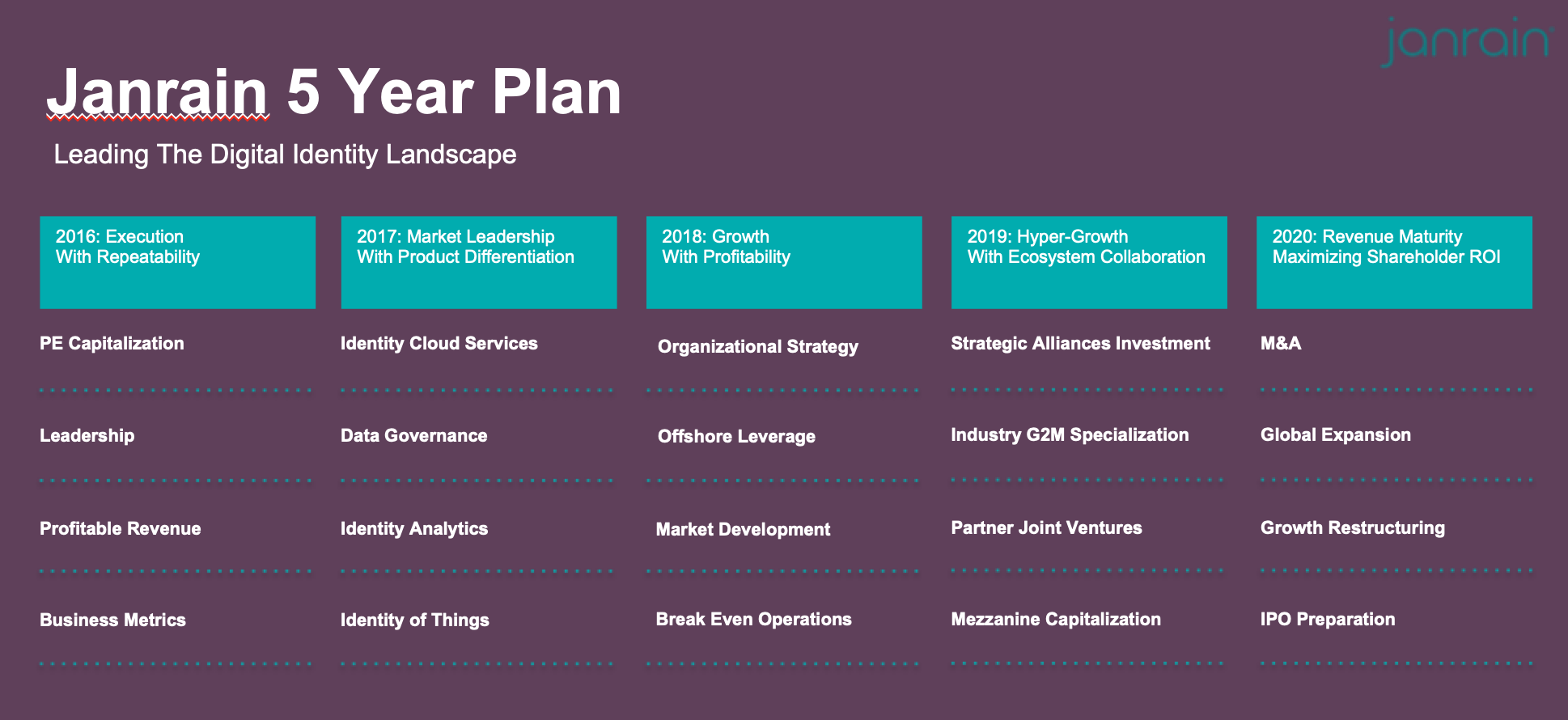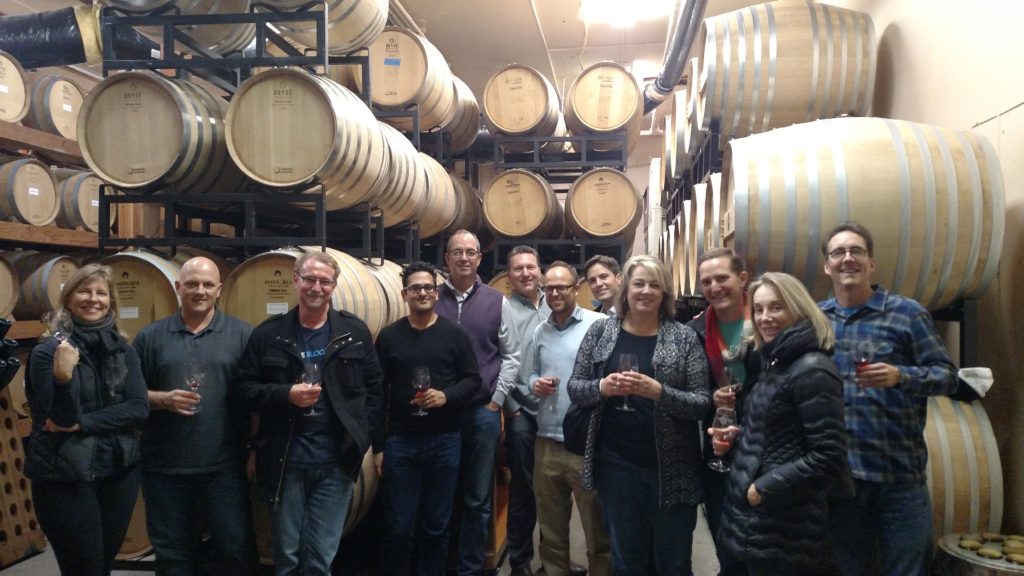The “aaS” Delivery Model
There were so many identity and access managment (IAM) vendors who grew up in the enterprise software / perpetual license / on-premise / single-tenant domain. All of them (for example, Ping Identity), were quickly disrupted by the “cloud-natives”, like Okta.
When I was invited into the Janrain family, I had the benefit of knowing both worlds well. Knowing the value propositions of deploying behind the firewall (in your own data center or outsourced in a co-located partner data center), as well as delivering a single code base as a service in AWS, Azure, or GCP.
Ping was founded in 2002 and currently operates at around $150M in revenue with a potential future IPO later in 2019 speculated to be valued between $2B and $3B. Assuming a healthy growth rate of 50% YoY, $225M in revenue @ 3B by end of 2019 would be a 13x (that’s twice as much as Vista Equity Partners paid when they purchased Ping for $600M on $100M of revenue).
Okta was founded in 2009 and currently operates at around $399M in revenue with a marketcap of $11.4B – that is almost 29x.
The difference between 13x and 29x can be attributed to the fundamental difference between enterprise software vs. SaaS. Don’t let Ping’s cloud migration announcement confuse you, since it’s an early attempt to “cloudwash” their enterprise software for only a single component of their offering (directory services).
It’s now clear how “cloud-natives” like Okta can even get to $399M in revenue in 10 years versus how the “cloud-migrants” like Ping are only getting to $150M in 17 years. The DNA at the legacy companies will never be able to move fast enough. In fact, they will even try to build it themselves, either thinking they have the time and/or the ability to organically creating their cloud capabilities (how to build, how to run & maintain, how to market and sell).
Our 5 year plan
To review, Janrain created both annual and quarterly themes out 5 years, in order to establish a “roadmap” for the entire company to follow. It was, in fact, a way of providing a guide to handling all the change we were introducing. And it was my way of being in every meeting, every hallway discussion, participating in every decision…not physically, but virtually.
Cloud is the only Model (Qtr 4 out of 11)
2017’s theme (as shown in the above 5 year plan) was “Market Leadership With Product Differentiation”. I did this because I wanted the whole company to lay the seeds required to achieve the #1 position in our category (Customer Identity and Access Management).
I knew that it might take a year to truly realized value from the investments in the competitive advantage needed, and another year to have that reflected with customers deployments and analyst reports. My goal was to get back to #1 by no later than the end of 2018.
The unfortunate issue was with our team – we battled with the “non-cloudy”. We had debates on our cloud positioning because some of the team that didn’t understand it.
I was glad that 1Q17 was dedicated to defining everything that was needed to establish dominance in our cloud infrastructure and shore up all multi-tenant services behind our “Identity Cloud”. Luckily, the founder had migrated from a traditional software approach back when AWS was first launched in 2006. So instead of creating a cloud offering from scratch, we were focused on making our existing services more scalable and more highly available.
My four quarterly themes for 2017 where as follows (messaging straight from my materials for the senior team):
- Q1: Identity Cloud – We need to “redefine” the industry. It starts with our focus on simple but meaningful messaging to our business buyers. Cloud-centric thought leadership starts here.
- Q2: Data Governance – Building off of our compliances work, we need to establish not only a strong message for data governance with initiatives like GDPR, but we need to establish an ecosystem that can help us take our Identity Cloud to market with a focus around data governance.
- Q3: Data & Analytics – Back in April of 2016 we discussed building a “Center of Excellence for Data”. It’s now time to actually launch this ability in the form of investments in our core staff and data projects with our strategic customers.
- Q4: Identity of Things – Closing out the year successfully will require our “seat at the table” with identity of things. This means launching offerings and partnerships around this based on our successes through the year with customers like Philips, Hager, Mars, and Freesat.
1Q17 Playbooks
During 1Q17 we used many playbooks, including the following:
- Win Themes: How does a company regain it’s #1 status in the industry?
- How to Win Against The Competition: There are playbooks for bad behavior by the competition like: 1) underpricing (buying the customer), 2) FUD, 3) Knowing your competition’s key value props and positioning, 4) getting the whole organization aware and contributing to becoming #1.
- “Product Differentiation” Means What?: Looking at product, services, and partners and determining what to double down on – less is more.
- Vertical Strategy: How to align marketing and sales behind no more than three verticals at a time. Which ones? How to create vertical programs?
- Metrics In Review: Analyzing the past year vs. targets vs. benchmark vs. the next year.
- Building Pipeline with Marketing: A data-driven roll-up including inquiries to SQLs on inbound; SDR campaign calls/meetings to SQLs on outbound; and breaking it down to its components – email nurturing, SEM/SEO, ABM, events, partner MDF, content, content, and content.
- Forecasting current AND next quarter with Sales: Forecast methodologies that never miss.
- Delivering on Strategic Professional Services: How does a SaaS company build professional services that deliver ROI on time, on budget, and within scope.
- Non-Linearity with Laser-Focused Alliances: A three-tier partner model.
- A Path to 60% Product Velocity for Engineering: A playbook to reducing “Run the Engine”.
- Platform Capabilities by Region is more than Operations: Many SaaS companies don’t properly plan for global coverage – how to reduce impact on customers and on staff.
- Optimizing Your Support Model: 1) Support Definitions: Service-Level Severities (S1-3: contractual obligation) vs. Customer Priorities (P1-3: customer time-to-fix request) vs. Support Staff Levels (L1-3: organizational process flows), 2) Support Work Flows (analysis with actual ticket volumes), 3) Customer analysis of each severity level.
- Recruiting & Hiring A-Team Changes our Cultural Pyramid: 1) Identifying the top roles for each of your departments, 2) Specifications for those roles 3) Building lists of LinkedIn profiles to target 4) Allocating time to “get-to-know” candidates, regardless of whether you have an open position.
- Finalizing the Budget – Operating Letters: Have you ever given your senior team letters from the CFO that summarize/confirm headcount and expense models for your department; including the excel models that support them? It’s content, not form.
- Team Objectives Exercise – Top 5: This is the cornerstone playbook for senior team alignment every quarter. How to use it as a communication package for all the company.
- Senior Team 360: Performance vs. Potential as perceived by your peers. You’re not allowed to speak, only listen and say, “thank you”.
Our QBR Guest – Protecting the Base with Customer Success Account Management
I brought in Joshua Fox, who ran the Americas Digital Applications diversified business at CSC. He was one of the more creative guys when it came to account management (or in our world of SaaS, customer success managers or CSMs). We discussed: 1) how to segment clients into different customer success tiers, 2) the top reasons for losing clients, and 3) how to secure renewals (a process that starts the day you first close the client).
1Q17 Top 3 Issues
- Win Against The Competition: Since we only really had one significant competitor, our close rates should be 50%, right?
- RFP Process: Since we moved upstream, we were seeing a large increase in RFPs. Without the infrastructure to support this, we would have drowned.
- SDR Program: We moved the SDR team out of the sales org and into the marketing org. Then we rebooted it.
We also identified bonus areas of getting stability with our delivery partners and improve our training (in support of partners).
The Team
We brought the team to Beauregard Vineyards. For four generations, the Beauregard family has been working the land in Bonny Doon, CA growing premium wine grapes. Of course, this event was the last thing we did during our QBR.
Summary of quarters:
2Q16: Supercharging Your Leadership Team (Qtr 1 out of 11)
3Q16: Investing in Profitable Revenue (Qtr 2 out of 11)
4Q16: Making a Business “Repeatable” (Qtr 3 out of 11)
1Q17: The “aaS” Delivery Model (Qtr 4 out of 11)
2Q17: Compliance in the Cloud (Qtr 5 out of 11)
3Q17: Analytics in the Cloud (Qtr 6 out of 11)
4Q17: IoT affects All – Even Identity (Qtr 7 out of 11)
1Q18: Organizational Strategy (Qtr 8 out of 11)
2Q18: Extension Teams (Qtr 9 out of 11)
3Q18: When should you scale sales? (Qtr 10 out of 11)
4Q18: When do you achieve breakeven? (Qtr 11 out of 11)






